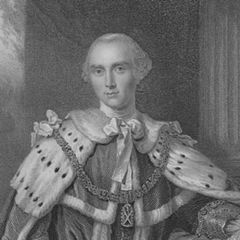John Stuart (3. hrabia Bute)
| Ten artykuł od 2021-06 wymaga zweryfikowania podanych informacji. |
 | |
| Data i miejsce urodzenia | 25 maja 1713 Edynburg |
|---|---|
| Data i miejsce śmierci | 10 marca 1792 Londyn |
| Premier Wielkiej Brytanii | |
| Okres | od 26 maja 1762 do 16 kwietnia 1763 |
| Przynależność polityczna | Torysi |
| Poprzednik | Thomas Pelham-Holles, 1. książę Newcastle |
| Następca | George Grenville |
| Odznaczenia | |
John Stuart (ur. 25 maja 1713 w Edynburgu, zm. 10 marca 1792 w Londynie) – premier w latach 1762-1763. Bute był nauczycielem Jerzego III i miał największy wpływ na politykę królewską od czasu jego wstąpienia na tron w roku 1760. Zakończył wojnę siedmioletnią, jednak pod naciskiem opinii publicznej podał się do dymisji.
Bute był pierwszą czołową postacią polityki westminsterskiej pochodzenia szkockiego od czasu unii Anglii i Szkocji w 1707.
Bute był przedtem nauczycielem następcy tronu Jerzego, później on i Jerzy III Hanowerski starali się wzmocnić władzę królewską, realizując tzw. Ideę Króla - Patrioty (The Idea of a patriot King), koncepcję silnej władzy królewskiej, którą dwa dziesięciolecia wcześniej opracował Henry St John, 1. wicehrabia Bolingbroke (1678-1751).
Bute nie miał jednak poparcia parlamentu, w którym był postrzegany jako "king's man", więc po roku musiał (mimo nacisków na parlament ze strony Jerzego III) ustąpić ze stanowiska. Koncepcję Bolingbroke'a-Bute'a zrealizował do pewnego stopnia dopiero William Pitt Młodszy (rzecz jasna z pomocą króla) po 1782 roku.
Media użyte na tej stronie
Autor: Image sourced from 'Medals of the World' website: http://www.medals.org.uk/index.htm, Licencja: CC BY-SA 2.5
Ribbon of the Order of the Garter
The pre-1801 Union Flag (of w:United Kingdom of Great Britain).
Autor: Sodacan, Licencja: CC BY-SA 3.0
Royal Coat of Arms of the United Kingdom of Great Britain and Northern Ireland in the style used by the Government of King Charles III from 2022 to the present (as used in all places except Scotland).
| “ | Quarterly, First and Fourth Gules three lions passant guardant in pale Or armed and langued Azure (for England), Second quarter Or a lion rampant within a double tressure flory counter-flory Gules (for Scotland), Third quarter Azure a harp Or stringed Argent (for Ireland), the whole surrounded by the Garter; for a Crest, the imperial crown Proper; for Supporters, dexter a lion rampant guardant Or crowned as the Crest, sinister a unicorn Argent armed, crined and unguled Proper, gorged with a coronet Or composed of crosses patée and fleurs de lys a chain affixed thereto passing between the forelegs and reflexed over the back also Or; Motto 'Dieu et mon Droit’ ('God and my Right') below the shield. | ” |
- PINCHES, J.H & R.V., The Royal Heraldry of England, 1974, Heraldry Today.
Autor: Image sourced from 'Medals of the World' website: http://www.medals.org.uk/index.htm, Licencja: CC BY-SA 2.5
Ribbon of the Order of the Thistle





